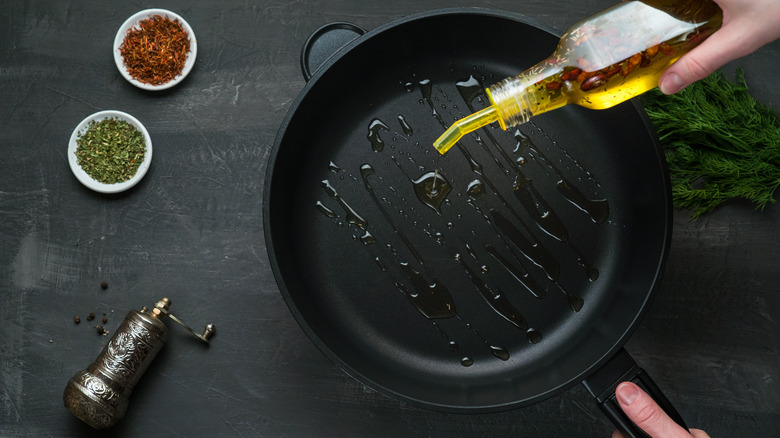The Mistake Everyone Makes When Cooking With Oil
You may have mastered cooking, but you might not have thought about one crucial aspect: the oil you use. If you're the type to use your trusty vegetable oil for everything from baking cupcakes to frying snapper, you're not alone. That being said, there's one mistake you might be making, and fixing it can up your cooking game big time.
According to Bon Appétit, the cooking oil you use can make or break your dish. In fact, one of the biggest mistakes any home cook makes is using the same oil for every meal. Luckily, this is a quick fix, as long as you know what oil works best for each cooking style. Warning against a one-oil-fits-all perspective, Bon Appétit's guide is extensive –- but very helpful in making your cooking Michelin star-level, with just a few easy swaps.
For one, there's a big difference between extra-virgin olive oil and light olive oil, and that goes for each oil's purpose, too. Extra-virgin olive oil, made from grinding olives via a cold-pressing method (via Tasting Table), is best used for vinaigrettes or as a finishing oil atop flatbreads or salads. It's also good for frying eggs and making ice cream (via Bon Appétit). While extra-virgin olive oil is too special for it not to be the star of the show, light olive oil is more versatile: use this high smoke-point oil for high-temperature cooking like roasting, grilling, sautéing, and baking if you're up for some robust flavor (via Healthline).
Cooking with the right oil can be a game-changer
Coconut oil, everyone's favorite cure-all for everything from dry skin to hair breakage, is a hero in the kitchen, too. Use this low smoke-point oil for gently sautéing meats and vegetables with a slight tropical taste, or even replace butter in any baking recipe. Since coconut oil is solid at room temperature, it can whip up just like butter (via MasterClass).
Nutty oils like peanut oil are in a class of their own and should be used for their robust taste — in the right dishes, of course. Per Bon Appétit, this oil is great for high-heat cooking up to 450 degrees and is perfect for deep-frying and cooking Asian dishes. Palm, corn, canola, and vegetable oils are all neutral-tasting, high-heat oils perfect for frying, whether making conch fritters or fried green tomatoes -– they're budget-friendly oils as well.
Hemp seed oil and flaxseed oil have complex flavors and a low smoke point, so use them sparingly as finishing oils atop salads or bowls. If your oil has "toasted" on the label, whether walnut, pistachio, or another make, it shouldn't be heated, so also use these for a final touch. Per Healthline, avocado oil is a kitchen superstar, with the highest smoke point of any oil, so use it for high-heat frying, searing, or grilling. Plus, it is truly neutral, so don't fret about it imparting any flavor on your dish. Once you know your oils, making your dishes shine will be second nature!

